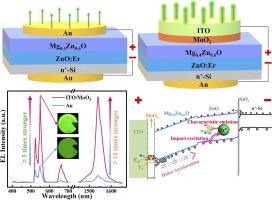通过使用 ITO/MoO3 组合阳极增强带有 Mg0.4Zn0.6O/ 掺铒 ZnO 异质结构的硅基发光器件的电致发光性能
IF 6.9
2区 材料科学
Q2 CHEMISTRY, PHYSICAL
引用次数: 0
摘要
我们利用半透明金膜作为阳极,从 Mg0.4Zn0.6O/ZnO:Er/n+-Si 异质结构发光器件(LED)中实现了与铒(Er)相关的可见光和近红外(NIR)电致发光(EL),其中 Er3+ 离子的撞击激发是通过 Mg0.4Zn0.6O 加速层中产生的热空穴实现的。然而,如何在 Mg0.4Zn0.6O/ZnO:Er/n+-Si 异质结构 LED 中同时实现更有效地向 Mg0.4Zn0.6O 层注入空穴和更强的发光能力仍然是一个挑战。针对这一问题,我们报告了在上述 LED 中用 ITO/MoO3 组合阳极取代金阳极以增强 EL 的情况。通过优化 MoO3 薄膜的厚度,用 ITO/MoO3 组合阳极取代金阳极,Mg0.4Zn0.6O/ZnO:Er/n+-Si 异质结构 LED 的电致发光效果得到增强,在可见光区的增强系数超过 5,在近红外区的增强系数超过 13。与金阳极相比,ITO/MoO3 组合阳极在可见光和近红外区域都具有更高的透射率和更大的折射率,以及更好的空穴注入能力,这些都是上述电致发光显著增强的原因。这项工作为将 ITO/MoO3 组合阳极应用到全无机 LED 中提供了启示。本文章由计算机程序翻译,如有差异,请以英文原文为准。

Enhanced electroluminescence from silicon-based light-emitting devices with Mg0.4Zn0.6O/erbium-doped ZnO heterostructures by using ITO/MoO3 combined anode
We have realized the erbium (Er)-related visible and near-infrared (NIR) electroluminescence (EL) from the Mg0.4Zn0.6O/ZnO:Er/n+-Si heterostructured light-emitting device (LED) using the semi-transparent Au film as the anode, where the impact-excitation of Er3+ ions is enabled by hot holes that are generated in the Mg0.4Zn0.6O acceleration layer. However, it remains a challenge to simultaneously achieve more efficient injection of holes into Mg0.4Zn0.6O layer and stronger light emanation for the Mg0.4Zn0.6O/ZnO:Er/n+-Si heterostructured LED. Addressing this issue, we report on the substitution of an ITO/MoO3 combined anode for the Au anode in the aforementioned LED to enhance the EL. Through the optimization of MoO3 film thickness, the substitution of ITO/MoO3 combined anode for Au anode leads to the enhanced EL from the Mg0.4Zn0.6O/ZnO:Er/n+-Si heterostructured LED with a factor of more than 5 in the visible region and with a factor of more than 13 in the NIR region. The higher transmittances and larger refraction indices in both visible and NIR regions and the better hole-injection capability of the ITO/MoO3 combined anode, with respect to those of Au anode, are responsible for the significantly enhanced EL as mentioned above. This work sheds light on the application of ITO/MoO3 combined anode into all-inorganic LEDs.
求助全文
通过发布文献求助,成功后即可免费获取论文全文。
去求助
来源期刊

Applied Surface Science
工程技术-材料科学:膜
CiteScore
12.50
自引率
7.50%
发文量
3393
审稿时长
67 days
期刊介绍:
Applied Surface Science covers topics contributing to a better understanding of surfaces, interfaces, nanostructures and their applications. The journal is concerned with scientific research on the atomic and molecular level of material properties determined with specific surface analytical techniques and/or computational methods, as well as the processing of such structures.
 求助内容:
求助内容: 应助结果提醒方式:
应助结果提醒方式:


